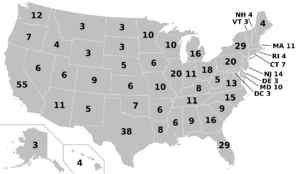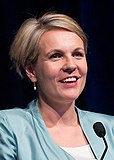2020 United States Presidential Election (LOTF RP)
This article is incomplete because it is pending further input from participants, or it is a work-in-progress by one author. Please comment on this article's talk page to share your input, comments and questions. Note: To contribute to this article, you may need to seek help from the author(s) of this page. |
| ||||||||||||||
538 members of the Electoral College 270 electoral votes needed to win | ||||||||||||||
|---|---|---|---|---|---|---|---|---|---|---|---|---|---|---|
| ||||||||||||||
 | ||||||||||||||
| ||||||||||||||
The 2020 United States presidential election is the 59th quadrennial presidential election, to be held on Tuesday, November 3, 2020. Incumbent President, Rick Tawney is not seeking election to a full-term after taking office in December of 2019 in the wake of the resignation of President Arnold Wolf. Subsequently, the Republican and Democratic Primaries in both parties have been incredibly competitive. This marks the third election since the 1952 Presidential Election, where an incumbent President or incumbent Vice-President did not seek the Presidency, after 2008 and 2016.
Background
Procedure
Article Two of the United States Constitution states that for a person to serve as president, the individual must be a natural-born citizen of the United States, at least 35 years old, and have been a United States resident for at least 14 years. Candidates for the presidency typically seek the nomination of one of the various political parties of the United States. Each party develops a method (such as a primary election) to choose the candidate the party deems best suited to run for the position. The primary elections are usually indirect elections where voters cast ballots for a slate of party delegates pledged to a particular candidate. The party's delegates then officially nominate a candidate to run on the party's behalf. The presidential nominee typically chooses a vice presidential running mate to form that party's ticket, which is then ratified by the delegates at the party's convention (with the exception of the Libertarian Party, which nominates its vice-presidential candidate by delegate vote regardless of the presidential nominee's preference). The general election in November is also an indirect election, in which voters cast ballots for a slate of members of the Electoral College; these electors then directly elect the president and vice president. If no candidate receives the minimum 270 electoral votes needed to win the election, the United States House of Representatives will select the president from the three candidates who received the most electoral votes, and the United States Senate will select the vice president from the candidates who received the two highest totals. The election will occur simultaneously alongside elections for the House of Representatives, Senate, and various state and local-level elections.
The Maine Legislature passed a bill in August 2019 adopting ranked-choice voting (RCV) both for presidential primaries and for the general election. The Governor of Maine allowed the bill to become law without her signature, which delayed it from taking effect until after the 2020 Democratic primary in March, but made Maine the first state to use RCV for a presidential general election. The Maine Republican Party filed signatures for a veto referendum and preclude the use of RCV for the 2020 election, but the Maine Secretary of State found there were insufficient valid signatures to qualify for the ballot. A challenge in Maine Superior Court was successful for the Maine Republican Party, but the Maine Supreme Judicial Court stayed the ruling pending appeal on September 8, 2020. Nevertheless, ballots began being printed later that day without the veto referendum and including RCV for the presidential election, and the Court ruled in favor of the Secretary of State on September 22, allowing RCV to be used. An emergency appeal to the U.S. Supreme Court was denied on October 6. Implementation of RCV could potentially delay the projection of the winner(s) of Maine's electoral votes for days after election day and may complicate interpretation of the national popular vote. The law continues the use of the congressional district method for the allocation of Maine's electors (Nebraska is the only other state that apportions its electoral votes this way).
On December 14, 2020, pledged electors for each candidate, known collectively as the United States Electoral College, will gather in their state's capital to cast their official ballot. The ballots are sent to Congress to be opened and officially counted pursuant to the processes laid out by the Electoral Count Act of 1887. The newly elected Congress will meet in joint session to open, count, and certify the ballots on January 6, 2021, with the sitting vice president (in his role as president of the Senate) presiding over the session.
Simultaneous elections
Further Information: 2020 United States Senate Elections and 2020 United States House of Representatives Elections
Nominations
Democratic Party nomination
Primaries
| |||||||||||||||||||||||||||||||||||||||||||||||
3,979 delegates to the Democratic National Convention 1,991 delegates needed to win 2,376 of 4,750 delegates needed to win any subsequent ballots at a contested convention | |||||||||||||||||||||||||||||||||||||||||||||||
|---|---|---|---|---|---|---|---|---|---|---|---|---|---|---|---|---|---|---|---|---|---|---|---|---|---|---|---|---|---|---|---|---|---|---|---|---|---|---|---|---|---|---|---|---|---|---|---|
| |||||||||||||||||||||||||||||||||||||||||||||||
 | |||||||||||||||||||||||||||||||||||||||||||||||
| |||||||||||||||||||||||||||||||||||||||||||||||
In August 2018, the Democratic National Committee voted to disallow superdelegates from voting on the first ballot of the nominating process, beginning with the 2020 election. This required a candidate to win a majority of pledged delegates from the assorted primary elections in order to win the party's nomination. The last time this did not occur was the nomination of Adlai Stevenson II at the 1952 Democratic National Convention. Meanwhile, six states used ranked-choice voting in the primaries: Alaska, Hawaii, Kansas, and Wyoming for all voters; and Iowa and Nevada for absentee voters.
After Diane Clifford's loss in the previous election, the Democratic Party was seen largely as leaderless, and was also seen as fractured between the centrist Clifford wing and the more progressive Baginski wing of the party, echoing the rift brought up in the 2016 primary election. In 2018, several U.S. House districts that Democrats hoped to gain from the Republican majority had contentious primary elections. Politico described these clashes as a "Democratic civil war". During this period, there was a general shift to the left in regards to college tuition, healthcare, and immigration among Democrats in the Senate.
The field began with 14 candidates before whittling down to 4 by Iowa.
| Date (daily totals) |
Total pledged delegates |
Contest and total popular vote |
Delegates won and popular vote | ||||
|---|---|---|---|---|---|---|---|
| Levi Murphy | Jillian Dayton | Mike Velez | John Donaldson | Other | |||
| February 3 | 41 | Iowa 176,364[a] |
16 70,475 (39.96%) |
14 60,110 (34.09%) |
6 24,770 (14.05%) |
5 21,002 (12.44%) |
7 |
| February 11 | 24 | New Hampshire 298,377 |
8 107,535 (36.0%) |
9 113,712 (38.1%) |
4 44,399 (14.9%) |
3 32,731 (10.9%) |
0 |
| February 22 | 36 | Nevada |
|||||
| February 29 | 54 | South Carolina | |||||
| March 3 (Super Tuesday) (1,344) |
52 | Alabama | |||||
| 6 | American Samoa | ||||||
| 31 | Arkansas | ||||||
| 415 | California | ||||||
| 67 | Colorado | ||||||
| 24 | Maine | ||||||
| 91 | Massachusetts | ||||||
| 75 | Minnesota | ||||||
| 110 | North Carolina | ||||||
| 37 | Oklahoma | ||||||
| 64 | Tennessee | ||||||
| 228 | Texas | ||||||
| 29 | Utah | ||||||
| 16 | Vermont | ||||||
| 99 | Virginia | ||||||
| March 3–10 | 13 | Democrats Abroad | |||||
| March 10 (352) |
20 | Idaho | |||||
| 125 | Michigan | ||||||
| 36 | Mississippi | ||||||
| 68 | Missouri | ||||||
| 14 | North Dakota | ||||||
| 89 | Washington | ||||||
| March 14 | 6 | Northern Mariana Islands | |||||
| March 17 (577) |
67 | Arizona | |||||
| 219 | Florida | ||||||
| 155 | Illinois | ||||||
| 136 | Ohio | ||||||
| March 24 | 105 | Georgia | |||||
| March 29 | 51 | Puerto Rico | |||||
| April 4 (107) |
15 | Alaska | |||||
| 24 | Hawaii | ||||||
| 54 | Louisiana | ||||||
| 14 | Wyoming | ||||||
| April 7 | 84 | Wisconsin | |||||
| April 28 (663) |
60 | Connecticut | |||||
| 21 | Delaware | ||||||
| 96 | Maryland | ||||||
| 274 | New York | ||||||
| 186 | Pennsylvania | ||||||
| 26 | Rhode Island | ||||||
| May 2 (46) |
7 | Guam | |||||
| 39 | Kansas | ||||||
| May 5 | 82 | Indiana | |||||
| May 12 (57) |
29 | Nebraska | |||||
| 28 | West Virginia | ||||||
| May 19 (115) |
54 | Kentucky | |||||
| 61 | Oregon | ||||||
| June 2 | 126 | New Jersey | |||||
| June 6 | 7 | U.S. Virgin Islands | |||||
Vice presidential selection
Nominee
Candidates
Republican Party nomination
Primaries
The Republican Primary was until January 2019 expected to be a pro-forma re-nomination of President Arnold Wolf. However, with his announcement that he would not seek a second term following diagnosis with brain cancer, the primary field was blown wide open. The primary began with 11 major candidates and was whittled to two by Iowa.
| Date (daily totals) |
Total pledged delegates |
Contest and total popular vote |
Delegates won and popular vote | ||||
|---|---|---|---|---|---|---|---|
| Nathaniel Richardson | Bernie Porter | ||||||
| February 3 | 40 | Iowa 177,585 |
24 105,485 |
16 72,099 | |||
| February 11 | 22 | New Hampshire | |||||
| February 19 | 50 | South Carolina | |||||
| February 22 | 25 | Nevada | |||||
| March 3 (785) |
50 | Alabama | |||||
| 40 | Arkansas | ||||||
| 172 | California | ||||||
| 37 | Colorado | ||||||
| 22 | Maine | ||||||
| 41 | Massachusetts | ||||||
| 39 | Minnesota | ||||||
| 71 | North Carolina | ||||||
| 43 | Oklahoma | ||||||
| 58 | Tennessee | ||||||
| 155 | Texas | ||||||
| 40 | Utah | ||||||
| 17 | Vermont | ||||||
| March 10 (300) |
19 | Hawaii | |||||
| 32 | Idaho | ||||||
| 39 | Kansas | ||||||
| 73 | Michigan | ||||||
| 40 | Mississippi | ||||||
| 54 | Missouri | ||||||
| 43 | Washington | ||||||
| March 14 | 9 | Guam | |||||
| March 15 | 9 | Northern Marianas | |||||
| March 17 (271) |
122 | Florida | |||||
| 67 | Illinois | ||||||
| 82 | Ohio | ||||||
| March 18 | 9 | American Samoa | |||||
| March 24 | 76 | Georgia | |||||
| March 27 | 29 | North Dakota | |||||
| April 2 | 29 | Alaska | |||||
| April 4 (55) |
46 | Louisiana | |||||
| 9 | U.S. Virgin Islands | ||||||
| April 7 | 52 | Wisconsin | |||||
| April 17 | 48 | Virginia | |||||
| April 28 (283) |
28 | Connecticut | |||||
| 16 | Delaware | ||||||
| 38 | Maryland | ||||||
| 94 | New York | ||||||
| 88 | Pennsylvania | ||||||
| 19 | Rhode Island | ||||||
| May 5 | 58 | Indiana | |||||
| May 9 (115) |
57 | Arizona | |||||
| 58 | Indiana | ||||||
| May 12 (71) |
36 | Nebraska | |||||
| 35 | West Virgina | ||||||
| May 19 (74) |
46 | Kentucky | |||||
| 28 | Oregon | ||||||
| June 2 (146) |
19 | District of Columbia | |||||
| 27 | Montana | ||||||
| 49 | New Jersey | ||||||
| 22 | New Mexico | ||||||
| 29 | South Dakota | ||||||
| June 7 | 23 | Puerto Rico | |||||
Vice presidential selection
Nominee
Candidates
General Election
- ↑ Includes only the final caucus alignment, after voters supporting non-viable candidates in the first round were allowed to transfer their vote to a different candidate.






